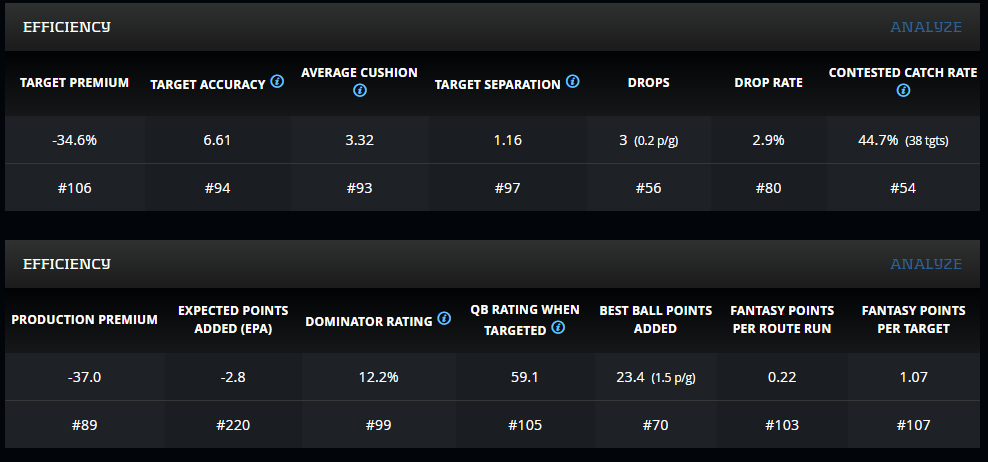An oft-repeated remark regarding NFL players, particularly when they find themselves on the market after leaving their most recent team, is that they “enjoyed some good production” at their last spot. This is usually spoken by one of the myriad NFL “insiders,” often sounding like a “they’re still good, honest” plea in order to help that player find another gig.
But like so many other things in this game of ours, the concept of “production” can be open to interpretation. There must be a way to drown out the noise and assess the true productivity of players against their peers. Well, lucky for you, there is. Production Premium is the latest in our Meet the Metric series.
What Is It?
Production Premium is a situation-agnostic efficiency metric. It compares the outcome of all pass attempts, carries, and targets to league-average outcomes in those same game situations (yard line, down, and distance). Production Premium also takes into account time remaining and game score to account for non-standard situations such as two-minute drills, clock-milking, and garbage time.
Players with positive values are more efficient than the average player. On the flip side, negative values indicate that a player is less efficient than his peers with similar opportunities in similar situations.
This metric is particularly helpful when assessing players after they change teams in free agency or are traded. This is because it measures a player’s capabilities across league-average situations. So their past exploits can still be measured even in their new surroundings.
Leaders and Losers
The last line of the above is particularly relevant, considering the identity of the leader in this metric among wide receivers in 2020. Will Fuller of the Houston Texans posted a Production Premium of +44.8, a good sign that he can continue to perform even in his new surroundings with the Miami Dolphins.
Two other players, both making their way to new teams in 2021, also featured among the top seven last season while on their old teams. Nelson Agholor posted a +26.3 (No. 6) Production Premium, while Corey Davis delivered a +24.3 (No. 7) mark. At the other end of the scale, the Arizona Cardinals may have bid against themselves in signing former star A.J. Green.
Green posted more than 1,000 yards in each of his first five seasons with the Bengals, also doing so in six of his first seven. But his 2020 campaign showed a player a long way past his best. He was neither productive, nor efficient, and finished with a -37.0 (No. 89) Production Premium.
Potential Buy Low Chance
Michael Thomas was one of the least productive players in the NFL by this metric. He posted a -19.1 (No. 86) Production Premium and was a huge disappointment to his fantasy managers everywhere.
But in my eyes, this presents something of a buy-low opportunity. Thomas is being taken in the mid-to-late third round in best ball drafts over at Underdog at present. This is a player who has led the NFL in receiving in the past while dealing with a quarterback with diminishing arm strength in Drew Brees.
Michael Thomas leads the NFL with 510 receptions since entering in 2016 ? pic.twitter.com/gCr829p6XQ
— RotoUnderworld (@rotounderworld) March 19, 2021
Heading into 2021, Thomas will either have Jameis Winston or Taysom Hill sending him the ball. Winston should be able to feed him targets further down the field than Brees was able to. While, as he saw last season, Hill will look the way of Thomas early, often, and again and again if he is the guy in New Orleans. I’d be stunned if Thomas was anywhere near the bottom of this group in a year’s time.
Stay safe.







